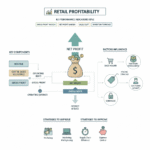The global retail landscape is undergoing a seismic shift, and its epicenter is no longer confined to the developed high streets of New York, London, or Tokyo. The new frontier is in the bustling, dynamic, and complex environments of emerging markets. From the vibrant kirana stores of India to the sprawling markets of Lagos and the digital-first consumers of Southeast Asia, technology is rapidly reshaping how goods are bought and sold.
However, this transformation is not a simple copy-paste of Western models. The adoption of retail technology in these regions presents a unique paradox: an incredible, high-stakes opportunity set against a backdrop of significant, entrenched barriers. For businesses looking to invest, and for AdSense publishers aiming to capture this audience, understanding this duality is key.
The Digital Gold Rush: Why Emerging Markets are the New Frontier for Retail Tech
The ‘why’ is simple: scale and speed. These markets are home to billions of young, digitally-native consumers who are rapidly gaining economic power. This creates a fertile ground for tech-driven retail growth.
The ‘Leapfrog’ Phenomenon: Skipping Legacy Systems
One of the most significant opportunities in emerging markets is the “leapfrog” effect. Unlike developed nations that built retail ecosystems around landlines, desktop PCs, and credit cards, many emerging markets have bypassed these stages entirely.
The smartphone is the primary (and often only) computer for a vast majority of the population. This mobile-first reality means that retailers are not burdened with supporting outdated legacy systems. They can build agile, mobile-first platforms from day one, focusing on apps, mobile payments, and social commerce. This allows for incredibly rapid innovation and adoption of new consumer-facing technologies.
A Burgeoning Middle Class and Urbanization
Across Africa, Latin America, and Southeast Asia, hundreds of millions of people are entering the middle class. This transition brings a surge in disposable income and a new appetite for consumer goods, convenience, and modern retail experiences. As populations move from rural areas to cities, their reliance on organized, tech-enabled retail and e-commerce grows exponentially, creating a massive, concentrated customer base.
The E-commerce and M-commerce Explosion
While global e-commerce growth is steady, in emerging markets, it’s explosive. This is driven by “m-commerce” (mobile commerce) and, increasingly, social commerce. Consumers are comfortable buying directly through platforms like WhatsApp, Instagram, and local super-apps (like Gojek or Rappi). This presents a massive opportunity for retailers to engage with customers on their preferred platforms, often at a lower acquisition cost than traditional web-based e-commerce.
Charting the Course: Key Technologies Driving the Change
The retail tech “stack” in emerging markets looks different from that in the West. The technologies that gain traction are those that solve fundamental, on-the-ground problems of access, trust, and logistics.
Mobile Payments and Digital Wallets
This is arguably the single most critical technology. In regions with low credit card penetration and a deep-seated reliance on cash, digital wallets and mobile payment systems are the primary enablers of e-commerce.
-
Financial Inclusion: Services like M-Pesa in Kenya or UPI in India have brought tens of millions of people into the formal digital economy, allowing them to pay for goods online and in-store for the first time.
-
Building Trust: These systems are often seen as more secure and transparent than traditional banking, helping to bridge the trust gap that inhibits online spending.
AI and Personalization at Scale
Artificial Intelligence is not just a buzzword; it’s a practical tool. With a mobile-first population, retailers are collecting vast amounts of data. AI is being used to:
-
Personalize Recommendations: Deliver hyper-relevant product suggestions to users on their mobile apps.
-
Optimize Inventory: Predict demand in highly fragmented markets to reduce waste and stockouts.
-
Power Chatbots: Provide 24/7 customer service in multiple local languages, a crucial function in diverse markets.
Supply Chain and Logistics Innovations
Selling a product online is the easy part; getting it to the customer is the real challenge. Technology is the only way to solve the complex “last-mile” delivery problem. This includes route optimization software for delivery drivers, AI-powered demand forecasting to place inventory in local micro-fulfillment centers, and even drone and robotic delivery trials in some areas.
The Tipping Point: Overcoming Significant Barriers to Adoption
For all the opportunity, the barriers to retail tech adoption are formidable. Ignoring them is a recipe for failure.
The Infrastructure Gap: Logistics and Connectivity
This is the most significant physical barrier. Outside of major urban hubs, retailers face:
-
Poor Logistics: Unreliable road networks, confusing (or non-existent) addressing systems, and a lack of cold-chain storage make delivery slow, expensive, and unpredictable.
-
Spotty Connectivity: While mobile penetration is high, data connectivity can be expensive and unreliable. A retail app or payment system that requires a constant, high-speed connection will fail. Technology must be lightweight, data-efficient, and capable of working offline.
Digital Literacy and the Skills Deficit
There are two sides to this coin. First is consumer literacy—building trust and teaching users how to navigate digital platforms. The second, and often more difficult, is retailer literacy.
A small “mom-and-pop” (or kirana) shop owner may not have the skills to manage a digital point-of-sale (POS) system, an online inventory, or a digital ledger. Successful tech platforms must be incredibly intuitive, simple, and provide strong in-person support and training.
Regulatory and Financial Hurdles
Navigating the legal landscape of dozens of countries is a major challenge. Data privacy laws, cross-border payment regulations, and complex tax structures can change overnight. Furthermore, many small retailers lack the access to capital needed to invest in new technology like a POS machine or a barcode scanner, even if they understand its benefits.
The Trust Deficit: Payments and Data Privacy
Trust is a fragile commodity. In many markets, the fear of online scams is high, which is why Cash-on-Delivery (COD) remains the dominant payment method. While this builds trust, it creates a logistical nightmare of cash handling and high return rates. Weaning consumers off COD and onto digital payments requires building iron-clad trust through reliable delivery, easy returns, and secure payment gateways.
Strategies for Success: How to Win in Emerging Markets
To succeed, companies cannot simply deploy their existing technology. They must adapt and innovate.
-
Hyper-Localization: This goes beyond translation. It means accepting local payment methods, understanding local holidays and shopping habits, and integrating with local delivery partners.
-
Build an Inclusive Ecosystem: The “winner-take-all” model rarely works. Successful platforms often partner with the existing informal economy—such as local kirana stores or individual delivery drivers—bringing them into the digital fold rather than trying to replace them.
-
Prioritize Simplicity and Value: The most successful tech is not the most complex; it’s the most reliable. A simple, WhatsApp-based ordering system that works on a 2G connection is more valuable than a beautiful, data-heavy app that doesn’t load.
In conclusion, the adoption of retail technology in emerging markets is one of the most exciting and challenging business stories of our time. The opportunities are generational, but they belong to those who understand that technology is not the end goal. It is a tool—one that must be adapted to solve real-world problems of infrastructure, literacy, and trust.


